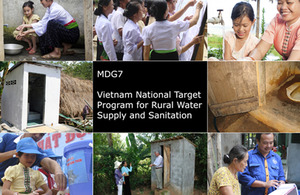MDG 7 - Household loans for rural water supply and sanitation in Vietnam
Vietnam has successfully achieved MDG 7 Target 7C, according to the most recent World Health Organization/UNICEF Joint Monitoring Report (2010). Vietnam has also made progress towards its own more challenging sector targets.

Various pictures of Vietnam water and sanitation projects
In 1998, the Government of Vietnam launched the National Target Programme (NTP) for rural water supply and sanitation. Six years later, in 2004, the government created a credit programme through the Bank for Social Policies designed to complement the NTP. The programme lends at subsidised interest rates to households so they can build or improve their water supply and sanitation facilities. The programme has made loans to more than 3.5 million households, a significant contribution towards achieving MDG target 7C. The credit programme operates alongside demand generation and helps respond to this demand. A government/donor sector status report from 2005 found that households were the largest investors in this sector.
The credit programme is innovative in that it avoids direct and full subsidies; rather, it subsidises the interest rate charged to borrowers. The programme leverages the household’s individual investment and responds to household demand. It also draws on technical guidance on appropriate designs from state agencies, and it follows government procedures and accounting rules. Credit program activities are facilitated by Vietnam’s Mass Organisations such as Veterans, Farmers, Women’s and Youth Unions.
Government and donors are currently seeking to close the gap between the demand for loans and the supply. The program must also reach poorer and more remote households, including areas of ethnic minorities, and it should harmonise with other approaches to rural sanitation and water supply. Further, the credit program does not work in isolation, but rather complements the government’s other subsidy policies and soft lending programs for households.
Vietnam has successfully achieved MDG 7 Target 7C, according to the most recent World Health Organization/UNICEF Joint Monitoring Report (2010). Vietnam has also made progress towards its own more challenging sector targets. According to the latest data, soon to be officially released, coverage of hygienic latrines is 55% and hygienic water supply is 80%.
Vietnam aims to achieve higher coverage than the MDG targets, and the credit program has made a significant contribution to this. The customer base has increased from 236,000 in 2006 to 1,320,000 in 2010.
Key facts
The National Target Programme (NTP) for Rural Water Supply and Sanitation is led by the Ministry of Agriculture and Rural Development; the Ministry of Health is responsible for sanitation and hygiene; and the Ministry of Education and Training is responsible for school sanitation.
Key donor partners to NTP are Australia, Denmark, Netherlands, and the UK; other donors include UNICEF, World Bank, Asian Development Bank, JICA and international NGOs.
Pilots for the credit programme of the Vietnam Bank for Social Policy began operation in 2004; the programme was rolled out in 2006 and is ongoing.
For further information, go to: www.agroviet.gov.vn and www.vbsp.org.vn